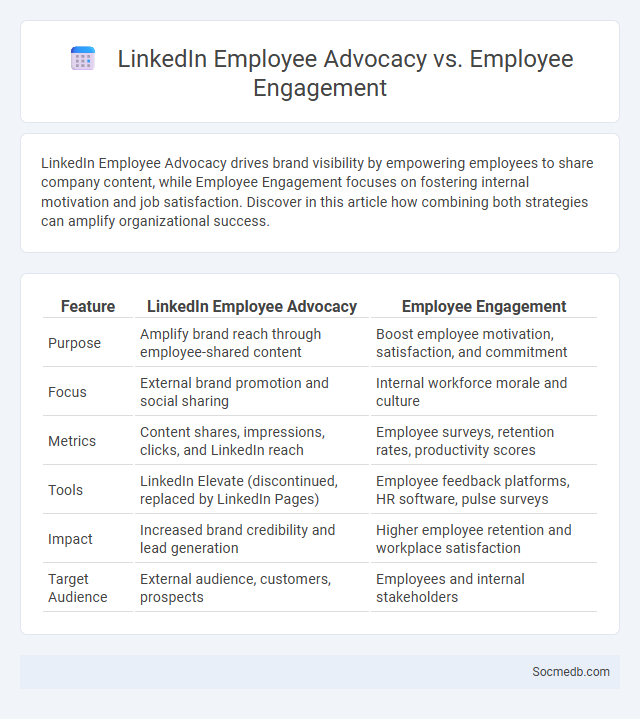
Photo illustration: LinkedIn Employee Advocacy vs Employee Engagement
LinkedIn Employee Advocacy drives brand visibility by empowering employees to share company content, while Employee Engagement focuses on fostering internal motivation and job satisfaction. Discover in this article how combining both strategies can amplify organizational success.
Table of Comparison
| Feature | LinkedIn Employee Advocacy | Employee Engagement |
|---|---|---|
| Purpose | Amplify brand reach through employee-shared content | Boost employee motivation, satisfaction, and commitment |
| Focus | External brand promotion and social sharing | Internal workforce morale and culture |
| Metrics | Content shares, impressions, clicks, and LinkedIn reach | Employee surveys, retention rates, productivity scores |
| Tools | LinkedIn Elevate (discontinued, replaced by LinkedIn Pages) | Employee feedback platforms, HR software, pulse surveys |
| Impact | Increased brand credibility and lead generation | Higher employee retention and workplace satisfaction |
| Target Audience | External audience, customers, prospects | Employees and internal stakeholders |
Understanding LinkedIn Employee Advocacy
LinkedIn employee advocacy leverages your workforce to authentically extend brand reach by sharing company content and insights, enhancing trust and engagement among professional networks. Employees acting as brand ambassadors amplify visibility, improve recruitment efforts, and boost organizational credibility through genuine interactions. Implementing effective LinkedIn advocacy programs drives organic growth, strengthens employer branding, and fosters a cohesive online presence for your company.
Defining Employee Engagement
Employee engagement on social media involves actively participating in online conversations and sharing content that reflects your company's values and culture. You boost organizational commitment by fostering transparent communication and recognition through platforms like LinkedIn, Twitter, and Instagram. This digital interaction enhances collaboration, morale, and overall productivity within your workforce.
What is Employee Advocacy?
Employee advocacy is a strategic approach where employees promote their company's brand, products, and values on social media platforms. Your employees become authentic brand ambassadors, sharing content and engaging with audiences to expand reach and build trust. This method leverages personal networks to amplify marketing efforts, boost brand credibility, and drive business growth.
Key Differences: LinkedIn Employee Advocacy vs Employee Advocacy
LinkedIn Employee Advocacy specifically leverages LinkedIn's professional network to amplify company messages through employees' profiles, enhancing B2B engagement and thought leadership. General Employee Advocacy encompasses broader platforms and channels beyond LinkedIn, including Facebook, Twitter, and Instagram, targeting diverse audience segments and fostering brand awareness across multiple social touchpoints. The strategic use of LinkedIn emphasizes professional credibility and industry-specific content, while general employee advocacy allows for more varied content types and broader demographic reach.
Employee Engagement vs Employee Advocacy: Core Distinctions
Employee engagement refers to the emotional commitment and involvement your employees have toward their work and company goals, while employee advocacy involves actively promoting your brand on social media and other platforms. Engaged employees are motivated and productive, but advocates go beyond by influencing external audiences, enhancing your company's reputation and reach. Understanding these core distinctions helps you tailor strategies that foster internal commitment and leverage external brand promotion effectively.
Benefits of LinkedIn Employee Advocacy for Brands
LinkedIn employee advocacy boosts brand visibility by leveraging your employees' professional networks to share authentic content, increasing reach and engagement. This leads to enhanced brand credibility and attracts top talent by showcasing your company's culture and values. Employee-driven promotion also drives higher trust and conversion rates compared to traditional marketing methods on social media platforms.
How Employee Engagement Impacts Advocacy Efforts
Employee engagement significantly boosts social media advocacy by transforming employees into genuine brand ambassadors who share authentic content and promote company values. High engagement levels correlate with increased sharing of positive messages, resulting in greater brand visibility and trust on social platforms. Companies with engaged employees experience more impactful advocacy efforts, driving stronger customer connections and enhanced reputation online.
Strategies for Enhancing Employee Advocacy on LinkedIn
Develop targeted content strategies that align with employees' professional expertise and interests, increasing authentic engagement on LinkedIn. Implement training programs to educate employees on best practices for sharing company news, industry insights, and personal achievements while maintaining brand consistency. Leverage LinkedIn analytics to monitor advocacy impact, optimize content types, and identify key employee influencers who can amplify the brand's reach effectively.
Measuring the Success of Advocacy and Engagement Initiatives
Measuring the success of social media advocacy and engagement initiatives involves tracking key performance indicators such as reach, impressions, shares, comments, and conversion rates. Analyzing sentiment analysis and audience demographics provides deeper insights into the effectiveness of messaging and community involvement. Leveraging tools like social listening platforms and engagement analytics dashboards enables organizations to optimize strategies and demonstrate tangible impact.
Choosing the Right Approach: Advocacy, Engagement, or Both?
Choosing the right social media strategy depends on your goals and audience; advocacy builds brand trust by encouraging user-generated content and word-of-mouth promotion, while engagement fosters direct interaction through comments, shares, and conversations. Balancing both advocacy and engagement can amplify your reach and deepen relationships, driving long-term loyalty and community growth. You should analyze your target demographic and business objectives to tailor a hybrid approach that maximizes impact across key platforms.
 socmedb.com
socmedb.com